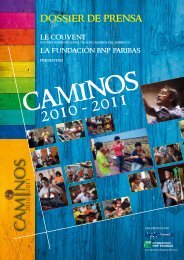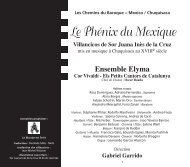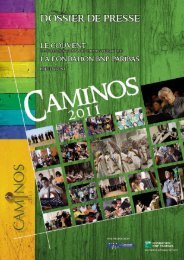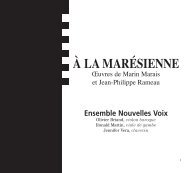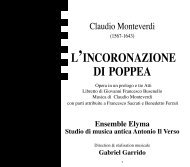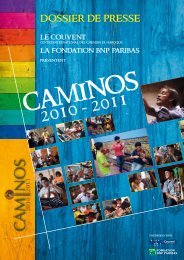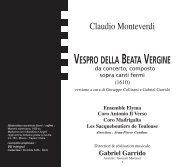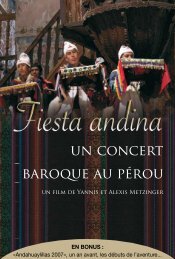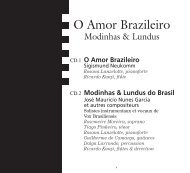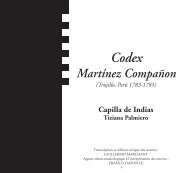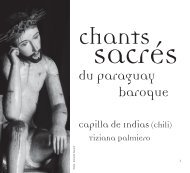Un voyage au cÅur des opéras de Jean-Baptiste Lully
Un voyage au cÅur des opéras de Jean-Baptiste Lully
Un voyage au cÅur des opéras de Jean-Baptiste Lully
Create successful ePaper yourself
Turn your PDF publications into a flip-book with our unique Google optimized e-Paper software.
<strong>Un</strong> <strong>voyage</strong><strong>au</strong> cœur <strong><strong>de</strong>s</strong> opéras<strong>de</strong> <strong>Jean</strong>-<strong>Baptiste</strong> <strong>Lully</strong>Barbara Kusa : <strong><strong>de</strong>s</strong>sus<strong>Jean</strong>-François Lombard : h<strong>au</strong>te-contreMarc M<strong>au</strong>illon : tailleEdwin Crossley-Mercer : basse tailleLes Pages, les Chantres et les Symphonistesdu Centre <strong>de</strong> Musique Baroque <strong>de</strong> VersaillesMusica Florea(dir. Marek Štryncl)Direction : Olivier Schneebeli1
Les circonstances <strong>de</strong> l’enregistrementCet enregistrement a été réalisé par Radio France<strong>au</strong> Manège Royal <strong><strong>de</strong>s</strong> Gran<strong><strong>de</strong>s</strong> Ecuries du Châte<strong>au</strong> <strong>de</strong> Versailles,dans le cadre <strong><strong>de</strong>s</strong> concerts organisés par le Centre <strong>de</strong> Musique Baroque <strong>de</strong> Versailles,les 29 et 30 mai 2005.Circumstances of the recordingThis recording was ma<strong>de</strong> by Radio Franceat the Manège Royal <strong><strong>de</strong>s</strong> Gran<strong><strong>de</strong>s</strong> Ecuries in Versailles Palace,at concert performances organised by the Centre <strong>de</strong> Musique Baroque <strong>de</strong> Versailles,on 29 and 30 May 2005.2
Ouverture1 Ouverture, Isis (1677) 2'57Prologue : La Renommée2 Isis, Prologue, scène 1 : « Publions en tous lieux … » 4'34Acte I : Voyages et métamorphoses3 Isis, acte IV, scène 1, chœur <strong><strong>de</strong>s</strong> Peuples <strong><strong>de</strong>s</strong> climats glacez : « L’hyver qui nous tourmente … » 3'194 Isis, acte IV, scène 3, chœur <strong><strong>de</strong>s</strong> Chabyles : « Tôt, tôt, tôt, … » 2'175 Isis, acte III, scènes 3 à 6, Syrinx et les Nymphes : « Liberté, liberté … » 8'276 Isis, acte III, scène 6, Chœur <strong>de</strong> Sylvains, <strong>de</strong> Satyres et <strong>de</strong> Bergers : « Aimons sans cesse … » 6'337 Isis, acte III, scène 6 (fin), Pan : « Hélas ! Quel bruit ! … » 6'30Acte II : La Paix8 Amadis (1682), acte V, scène <strong>de</strong>rnière, chaconne : « Chantons tous, en ce jour, … » 13'44Acte III : La Guerre9 Alceste (1674), acte II, scènes 3 et 4 : « Marchez, marchez, marchez, … » 6'09Acte IV : Enfers et maléfices10 Isis, acte IV, scène 7, les Parques : « Le fil <strong>de</strong> la vie … » 4'1611 Persée (1682), acte III, scène 1, Méduse : « J’ay perdu la be<strong>au</strong>té …» 6'38Acte V : Les Plaisirs enchantés12 Armi<strong>de</strong> (1686), acte V, scène 2, passacaille : « Les Plaisirs ont choisi pour azile … » 10'04minutage total : 1h15'353
« Les Plaisirs ont choisipour asile … »<strong>Un</strong> <strong>voyage</strong> <strong>au</strong> cœur <strong><strong>de</strong>s</strong> opéras<strong>de</strong> <strong>Jean</strong>-<strong>Baptiste</strong> <strong>Lully</strong>‘The Pleasures have electedtheir domain . . .’A journey to the heart of theoperas of <strong>Jean</strong>-<strong>Baptiste</strong> <strong>Lully</strong>Le présent enregistrement est l’aboutissementd’un projet <strong>de</strong> longue date. Plus que cela, il est laconcrétisation d’un rêve caressé <strong>de</strong>puis <strong><strong>de</strong>s</strong> années.Ce rêve, je l’avais déjà entrevu lorsque, à l’occasion<strong><strong>de</strong>s</strong> cours <strong>de</strong> déclamation que je dispense à mesétudiants, nous avions monté l’acte III d’Isis, œuvreemblématique, à mes yeux, dans la mesure où c’estpar elle (c’était dans les années soixante …) quej’ai contracté le virus <strong>de</strong> la musique ancienne, et,tout particulièrement, celui <strong>de</strong> la musique baroquefrançaise.Il y a <strong>de</strong> cela trois ans, Vincent Berthier <strong>de</strong> Lioncourtm’a proposé <strong>de</strong> monter avec Les Pages et les Chantresdu Centre <strong>de</strong> Musique Baroque <strong>de</strong> Versailles etl’orchestre Musica Florea, un programme consacré<strong>au</strong>x grands chœurs, chaconnes, passacailles tirés<strong><strong>de</strong>s</strong> opéras <strong>de</strong> <strong>Lully</strong>. Il s’agissait, en l’occurrence,<strong>de</strong> réaliser <strong><strong>de</strong>s</strong> concerts, <strong>de</strong> produire un disque quipuisse servir d’outil <strong>de</strong> travail à l’Académie Equestre<strong>de</strong> Bartabas avec qui nous avions déjà travaillé.The present recording marks the accomplishmentof a long-standing project. More than that, it hasallowed me to give concrete form to a dream I havecherished for years.I had already had a glimpse of that dream when, aspart of the lessons in <strong>de</strong>clamation I give my stu<strong>de</strong>nts,we performed Act III of Isis, an emblematic work forme in that it was from this opera that (back in the1960s!) I first c<strong>au</strong>ght the virus of early music, andmore especially the French Baroque strain of it.Three years ago, Vincent Berthier <strong>de</strong> Lioncourtsuggested I should create, along with Les Pages et lesChantres du Centre <strong>de</strong> Music Baroque <strong>de</strong> Versaillesand the orchestra Musica Florea, a programme<strong>de</strong>voted to the great choruses, chaconnes, andpassacailles from <strong>Lully</strong>’s operas. The i<strong>de</strong>a was toperform a series of concerts and produce a recordingthat could be used by the Académie Equestre ofBartabas, with whom we had already worked.Afin <strong>de</strong> conserver une forme <strong>de</strong> cohérencedramatique à l’ensemble (<strong>Lully</strong>, aidé <strong>de</strong> son librettisteQuin<strong>au</strong>lt, reste l’un <strong><strong>de</strong>s</strong> plus formidables dramaturges6In or<strong>de</strong>r to maintain a <strong>de</strong>gree of overall dramaticcoherence (<strong>Lully</strong>, with the help of his librettistQuin<strong>au</strong>lt, remains one of the most tremendous
<strong>de</strong> toute l’histoire <strong>de</strong> l’opéra), j’ai préféré, plutôtque d’aligner bout à bout <strong><strong>de</strong>s</strong> extraits, <strong>au</strong>ssi be<strong>au</strong>xfussent-ils, concevoir un nouvel opéra, une sorte<strong>de</strong> concentré archétypique <strong>de</strong> la tragédie lyrique,telle que l’a créée « <strong>Baptiste</strong> », avec les passagesobligés, les « détours incontournables », les thèmesimmuables qui font <strong>de</strong> cette somme opératique,quelque chose, à mes yeux, d’<strong>au</strong>ssi important etradical que l’opéra wagnérien <strong>de</strong>ux siècles plus tard.Bien sûr, dans cet enregistrement, il fallait fairela part belle avant tout <strong>au</strong> chœur et à l’orchestre,ce qui excluait d’emblée les gran<strong><strong>de</strong>s</strong> scènes <strong>de</strong>protagonistes, ces fameux récitatifs que RomainRolland avait qualifiés <strong>de</strong> mornes « steppes », toutsimplement, parce qu’à son époque, on ne savaitplus comment les dire.Cela équivalait à faire <strong>de</strong> ce « nouvel » opéra, unepièce exclusivement composée <strong>de</strong> ce qu’on nomme,dans la tragédie lyrique, les divertissements.Tant pis, ou plutôt, tant mieux !Car dans la tragédie lullyste, ceux-ci, contrairement àce qui se passera dans la plupart <strong><strong>de</strong>s</strong> opéras françaispostérieurs, sont si habilement intégrés à l’actiondramatique, qu’ils y participent pleinement et,parfois même, en renforcent les effets (j’en veuxpour seule preuve, le divertissement <strong>de</strong> l’acte IV <strong>de</strong>Roland qui sert <strong>de</strong> déclencheur à la folie du héros).Et puis, ce sont les moments, dans la tragédie lyrique,qui laissent le plus <strong>de</strong> part <strong>au</strong> merveilleux, élémentindissociable <strong>de</strong> l’art baroque, à la poésie, à lamusique surtout.Bien évi<strong>de</strong>mment, il me fallait offrir une place <strong>de</strong>choix à Isis, « l’opéra <strong><strong>de</strong>s</strong> musiciens », celui-là mêmequi avait tant décidé <strong>de</strong> mes appétits futurs.D’où le choix <strong>de</strong> l’Ouverture, du Prologue intituléici « la Renommée » et qui célèbre la gloire d’un7dramatists in the whole history of opera), I <strong>de</strong>ci<strong>de</strong>dnot to string together a succession of extracts,however fine they might be individually. I preferredinstead to conceive a new opera, a sort of con<strong>de</strong>nsedarchetype of the tragédie lyrique as created by‘<strong>Baptiste</strong>’, with the indispensable passages, the ‘mustmoments’, the immutable themes which make hisoperatic oeuvre, in my view, as important and radicalas Wagnerian opera two centuries later.Of course, in this recording, it was necessary togive pri<strong>de</strong> of place to choir and orchestra, which<strong>au</strong>tomatically exclu<strong>de</strong>d the great scenes for theprotagonists, those famous recitatives that RomainRolland called dreary ‘steppes’, quite simply bec<strong>au</strong>sein his day no-one knew how to <strong>de</strong>liver them anymore.This meant that the ‘new’ opera would consistexclusively of what in tragédie lyrique are called the‘divertissements’.Too bad – or rather, so much the better!For in Lullian tragedy – unlike most subsequentFrench operas – these scenes are so skilfullyintegrated with the dramatic action that they fullyparticipate in it, and sometimes even heightenits effects (one need look no further than thedivertissement in Act IV of Roland, which triggersoff the hero’s madness). Moreover, it is thesemoments that leave most room for le merveilleux,the supernatural, fantastic element inseparable fromBaroque art, poetry, and music above all.It goes without saying that I had to offer a place ofhonour to Isis, the ‘musicians’ opera’, the very piecethat had so <strong>de</strong>termining an influence on my futureappetites.This explains why I have chosen to begin with itsOuverture, followed by the Prologue (here entitled
monarque jeune encore, à peine différent du jeuneroi en armure qu’a peint, quelques années avant, LeBrun.Du premier acte <strong>au</strong>ssi (« Voyages et métamorphoses »),résolument baroque, avec ses incursions dans <strong><strong>de</strong>s</strong>régions <strong>au</strong>ssi reculées et diverses que les désertsglacés <strong>de</strong> la Scythie et les brûlantes forges <strong>de</strong> Vulcain.<strong>Un</strong>e façon <strong>de</strong> rappeler, en même temps, que sans le« chœur <strong><strong>de</strong>s</strong> Trembleurs », traité dans un mo<strong>de</strong>, il estvrai, plus pittoresque que pathétique, Purcell n’eûtpeut-être pas imaginé sa tragique « Scène du Froid »du King Arthur. Que déjà, bien avant les Nibelungen,les mon<strong><strong>de</strong>s</strong> souterrains ont retenti, à l’opéra, duferraillement <strong><strong>de</strong>s</strong> marte<strong>au</strong>x sur l’enclume.Dans ce premier acte, j’ai voulu insérer <strong>au</strong>ssil’intégralité du divertissement situé <strong>au</strong> IIIème actedu même opéra, théâtre dans le théâtre (dans latradition spécifiquement baroque dont L’Illusioncomique <strong>de</strong> Corneille reste l’archétype), véritablemise en abyme <strong>de</strong> la tragédie elle-même, puisque,pour faire diversion, et détourner les cent yeux duredoutable Argus <strong>de</strong> sa prisonnière, la malheureuseIo, Mercure imagine <strong>de</strong> faire voir <strong>au</strong> geôlier lareprésentation d’<strong>au</strong>tres amours à l’issue tragique,celles <strong>de</strong> Pan pour la nymphe Syrinx.‘La Renommée’) which celebrates the glory of a stillyoung monarch, scarcely changed from the youthfulking in armour painted by Le Brun a few years earlier.From the same source comes the first act (‘Voyageset métamorphoses’), resolutely Baroque, with itsincursions into regions as distant and as different asthe icy wastes of Scythia and the burning forges ofVulcan. This act also offers a timely remin<strong>de</strong>r thatwithout the ‘chœur <strong><strong>de</strong>s</strong> Trembleurs’, admittedlytreated in picturesque rather than pathetic mo<strong>de</strong>,Purcell might perhaps never have conceived the‘Frost Scene’ in King Arthur – and that, long beforethe Nibelungs, subterranean worlds had alreadyresoun<strong>de</strong>d, in the opera house, with the clang ofhammers on anvils.I also wished to insert in this first act the completedivertissement from the third act of the same opera,which presents a theatre within the theatre (in thespecifically Baroque tradition of which Corneille’sL’Illusion comique remains the archetype), an<strong>au</strong>thentic mise en abyme of the tragedy itself, since,to create a diversion and distract the hundred eyesof the fearsome Argus from his unfortunate captiveIo, Mercury <strong>de</strong>vises the ploy of showing the gaoleranother love affair with a tragic outcome, Pan’spassion for the nymph Syrinx.Isis, l’opéra <strong><strong>de</strong>s</strong> Métamorphoses. Celles d’Ovi<strong>de</strong>,<strong>au</strong>quel le livret <strong>de</strong> Quin<strong>au</strong>lt emprunte ses sources.Celles <strong>de</strong> toute une Cour, puisqu’on a voulu voir enJupiter amoureux le Roi lui-même (chose sommetoute assez banale), en Io, la nymphe aimée,persécutée par la jalouse Junon, la favorite dumoment, Ma<strong>de</strong>moiselle <strong>de</strong> Ludre, Fille d’honneur<strong>de</strong> Madame, en butte à la jalousie non point <strong>de</strong> laReine « habituée désormais à ses infidélités » (Primi-Visconti), mais <strong>de</strong> la toute puissante favorite en titre,Madame <strong>de</strong> Montespan. Cette <strong>de</strong>rnière finit partriompher et la trop jeune rivale, après avoir connula plupart <strong><strong>de</strong>s</strong> avanies <strong>de</strong> la nymphe, son double, ne<strong>de</strong>viendra point comme Isis, déesse à tête <strong>de</strong> vache.8Isis is the opera of metamorphoses. The work ofthat name by Ovid, in which Quin<strong>au</strong>lt’s libretto hasits sources. But also those of the whole court, forthe amorous Jupiter was i<strong>de</strong>ntified with the kinghimself (a fairly banal notion, when all is said anddone), and Io, the nymph he loves and who ispersecuted by jealous Juno, with the current royalfavourite, Ma<strong>de</strong>moiselle <strong>de</strong> Ludre, maid of honourto ‘Madame’ 1 , who was exposed to the jealousynot of the queen, ‘used by now to his infi<strong>de</strong>lities’(Primi-Visconti), but of Louis’ all-powerful officialmistress, Madame <strong>de</strong> Montespan. It was the latterwho triumphed in the end, though her all too youngrival, <strong><strong>de</strong>s</strong>pite suffering most of the same snubs as her
« Elle va reprendre sa p<strong>au</strong>vre vie ordinaire » conclutMadame <strong>de</strong> Sévigné, dans une lettre datée du 23juin 1677.Cette chute et cet opéra v<strong>au</strong>dront à Quin<strong>au</strong>lt ladisgrâce, le temps d’une saison, celle <strong>de</strong> Bellérophon,dont le livret est alors confié <strong>au</strong> jeune frère du grandCorneille, Thomas.Pourtant le poète a donné <strong>au</strong> musicien l’occasionici, et notamment dans la scène <strong>de</strong> Pan et Syrinx,<strong>de</strong> développer tout son art poétique, et son sens<strong>de</strong> la couleur, <strong><strong>de</strong>s</strong> contrastes les plus frappants,<strong>de</strong> l’ombre et <strong>de</strong> la lumière. Doubles chœurs <strong>de</strong>Nymphes et <strong>de</strong> Satyres, danses variées utilisantlargement l’apport <strong><strong>de</strong>s</strong> instruments « champêtres » :h<strong>au</strong>tbois, flûtes, musette. Et cette « chasse » quiannonce avec tellement d’éclat, celle d’Hippolyte etAricie <strong>de</strong> Rame<strong>au</strong>, juste avant la fuite éperdue et lamétamorphose <strong>de</strong> Syrinx en rose<strong>au</strong>.Et là, le chef-d’œuvre <strong>de</strong> l’acte, cette longueplainte <strong>de</strong> Pan se mêlant <strong>au</strong>x murmures duvent dans les rose<strong>au</strong>x, l’une <strong><strong>de</strong>s</strong> plus touchantes« métamorphoses » poétiques imaginées par <strong>Lully</strong>.Mon pessimisme, sans doute, a voulu que je fasseprécé<strong>de</strong>r « La Guerre » par « La Paix » et non lecontraire. Mais <strong>au</strong>ssi, sans doute, ma gourmandise quine s’est pas résolue à choisir, dans la « construction »d’un même opéra, entre une chaconne et unepassacaille.nymphean counterpart, did not end up, like Isis, asa god<strong><strong>de</strong>s</strong>s with the head of a cow. ‘She will go backto her poor ordinary life’, conclu<strong>de</strong>d Madame <strong>de</strong>Sévigné in a letter dated 23 June 1677.Her fall, and the opera’s association with it, earnedQuin<strong>au</strong>lt a season’s disgrace, during which the nextlibretto to be set by <strong>Lully</strong>, Bellérophon, was entrustedto Thomas Corneille, younger brother of the greatdramatist.Yet the disgraced librettist had given the musicianthe opportunity – in the scene with Pan and Syrinxespecially – to <strong>de</strong>velop to the full his poetic art andhis feeling for colour, for the most striking contrasts,for light and sha<strong>de</strong>. Double choruses of Nymphsand Satyrs, varied dances making extensive use of‘rustic’ instruments: oboes, flutes, musette. Thenthere is the ‘hunt’ which so splendidly foreshadowsthe corresponding scene in Rame<strong>au</strong>’s Hippolyte etAricie, just before the headlong flight of Syrinx andher transformation into a reed.And now occurs the act’s masterpiece, a long lamentfor Pan mingling with the murmuring of the breezein the reeds, one of the most touching poetic‘metamorphoses’ ever conjured up by <strong>Lully</strong>.It was doubtless my pessimism that ma<strong>de</strong> me place‘La Paix’ before ‘La Guerre’, rather than the otherway round. But it was also, without a doubt, mygluttonous appetite which ma<strong>de</strong> it impossible forme, in ‘constructing’ a single new opera, to choosebetween a chaconne and a passacaille.La chaconne, donc, se situe <strong>au</strong> IIème acte du présentenregistrement. C’est sans doute, avec celle d’Aciset Galatée, la plus développée qu’ait écrite <strong>Lully</strong>.Architecture <strong>de</strong> longue haleine, propre à conclure unopéra dans une atmosphère d’euphorie hypnotique,elle termine Amadis, œuvre qui, selon PhilippeBe<strong>au</strong>ssant, marque « un retour <strong>au</strong>x notions et <strong>au</strong>x9The chaconne, then, appears in the second act ofthe present recording. It is certainly, along with itscounterpart in Acis et Galatée, the most exten<strong>de</strong>dthat <strong>Lully</strong> wrote. Its long-term architecture, a fittingchoice to end an opera in an atmosphere of hypnoticeuphoria, forms the finale to Amadis, a work which,in the view of Philippe Be<strong>au</strong>ssant, marks ‘a return to
valeurs du baroque », avec « le regain <strong>de</strong> faveur <strong><strong>de</strong>s</strong>thèmes héroïques et chevaleresques ». Pour nous,ce somptueux édifice, où l’orchestre et le chœuramplifient le bonheur <strong><strong>de</strong>s</strong> parfaits chevaliers et <strong>de</strong>leurs dames, dans le cadre verdoyant et calme <strong>de</strong>forêts enchantées, termine la première partie <strong>de</strong>cette pièce, avant que ne lui succè<strong>de</strong>, avec le IIIèmeacte, une « Guerre » toute pleine <strong><strong>de</strong>s</strong> échos redoublésdu triomphal Prologue.Il s’agit du fameux siège d’Alceste (1674), <strong>de</strong> cettebataille en musique où le bruit <strong><strong>de</strong>s</strong> tambours, l’éclat<strong><strong>de</strong>s</strong> trompettes et l’affrontement <strong><strong>de</strong>s</strong> doubles chœurs,<strong>au</strong>rait pu faire dire à une quelconque marquise(n’oublions pas que les Dames étaient conviées par leRoi sur le lieu <strong>de</strong> ses campagnes et que l’on assistaitparfois <strong><strong>de</strong>s</strong> carrosses, tenus à l’écart, <strong>au</strong> déroulement<strong><strong>de</strong>s</strong> batailles) : « Dieu que la guerre est jolie ! »the concepts and values of the Baroque’, with ‘therevival of interest in heroic and chivalrous themes’.This sumptuous edifice, in which orchestra and chorusmagnify the happiness of these perfect gentle knightsand their ladies in the calm and verdant setting ofenchanted forests, is used here to bring our firstpart to a conclusion. It will be succee<strong>de</strong>d, in the thirdact, by a ‘Guerre’ full of redoubled echoes of thetriumphal Prologue.This is the famous siege from Alceste (1674), a battleset to music whose roaring drums, braying trumpetsand clashing double choruses might have promptedsome marquise (let us not forget that the ladies wereinvited by the king to accompany his campaigns, andthat they sometimes looked on from their carriages,at a safe distance, as battle was joined) to exclaim:‘God, how pretty war is!’Il n’est pas d’opéra baroque sans acte infernal.Là encore, j’en ai emprunté une partie à Isis. A sonextraordinaire trio <strong><strong>de</strong>s</strong> Parques, qui nous donne àentendre, tout à la fois, l’éternel mouvement durouet filant les vies, et la suspension du temps, dansune sorte <strong>de</strong> murmure indicible et angoissant.D’une certaine façon, puisqu’on parlait <strong>de</strong> la mort,du néant inéluctable, il me fallait « humaniser »ces enfers. Les humaniser dans la figure à la foisatroce, grotesque et pathétique <strong>de</strong> Méduse, cettebe<strong>au</strong>té transformée en monstre par la jalousie d’unedéesse. La Méduse <strong>de</strong> Persée (1682) est sans doutel’un <strong><strong>de</strong>s</strong> personnages les plus déchirants imaginés parQuin<strong>au</strong>lt et <strong>Lully</strong>, et cet acte, qui n’est pratiquementqu’un acte <strong>de</strong> « divertissement », prouve encore,s’il le fallait, que ces passages, dans l’opéra lullyste,ne doivent guère être pris à la légère. Encore f<strong>au</strong>tildonner <strong>au</strong> personnage l’épaisseur et le poids <strong><strong>de</strong>s</strong>ouffrance que la musique elle-même suggère. Etpuis, ce qui m’a définitivement fait choisir cette scènepour l’acte infernal, c’est qu’elle s’achève sur un« sommeil », <strong>au</strong>tre moment quasi incontournable<strong>de</strong> l’opéra lullyste, <strong>au</strong>tre moment où dans cette10One cannot imagine a Baroque opera without an actset in the un<strong>de</strong>rworld.Here too I have borrowed material from Isis. Tobe more precise, from its extraordinary trio forthe Parcae or Fates, which lets us hear both themovement of the wheel that spins out our lives,and the suspension of time in a sort of unutterable,agonising murmur.In a sense, since the subject is <strong>de</strong>ath, inescapableoblivion, I nee<strong>de</strong>d to ‘humanise’ this un<strong>de</strong>rworld.To humanise it through the dreadful, grotesqueyet pathetic figure of Medusa, that be<strong>au</strong>ty turnedinto a monster by the jealousy of a god<strong><strong>de</strong>s</strong>s. TheMedusa of Persée (1682) is undoubtedly one of themost heartrending characters created by Quin<strong>au</strong>ltand <strong>Lully</strong>, and this act, which is almost entirely oneof ‘divertissement’, proves once more, if that werenecessary, that such passages in Lullian opera arescarcely to be taken lightly. But one must still contriveto give the character the <strong>de</strong>nsity and weight ofsuffering suggested by the music itself. What finallyma<strong>de</strong> me choose this scene for the ‘infernal’ act isthe fact that it ends with a ‘sommeil’ (sleep scene),
architecture musicale définitivement géniale, lapoésie, le rêve s’engouffrent dans la tragédie. Ici lesmonstres, frappés <strong>de</strong> stupeur, fascinés, se prennentà rêver (à leur antique splen<strong>de</strong>ur, sans doute) <strong>au</strong> son<strong><strong>de</strong>s</strong> douces harmonies générées par la <strong><strong>de</strong>s</strong>cente <strong>de</strong>Mercure <strong>au</strong>x Enfers.Tout naturellement, dans la paix, la sérénitéretrouvées, peut s’enchaîner le <strong>de</strong>rnier acte, lafameuse passacaille, le chef-d’œuvre absolu, tiré d’unabsolu chef-d’œuvre : Armi<strong>de</strong>.Retour <strong>au</strong> classicisme <strong><strong>de</strong>s</strong> années 1660-1670 selonP<strong>au</strong>l Benichou, cité par Philippe Be<strong>au</strong>ssant. Sansdoute. Mais n’oublions pas que, cette fois, la forêtenchantée est vénéneuse, que l’euphorie - icipresque sacrée - <strong>de</strong> la passacaille s’abîmera bientôtdans le désastre <strong>de</strong> la séparation, la <strong><strong>de</strong>s</strong>truction dupalais enchanté, et les imprécations cruelles <strong>de</strong> ladélaissée, re<strong>de</strong>venue « Méduse ». C’est pourquoicette passacaille en sol mineur qui célèbre, une fois<strong>de</strong> plus, le pouvoir <strong>de</strong> l’amour et la splen<strong>de</strong>ur <strong>de</strong> sonenchantement, annonce <strong>au</strong>ssi la mort inéluctable,celle <strong>de</strong> l’Amour, celle <strong><strong>de</strong>s</strong> Passions, celle <strong><strong>de</strong>s</strong> Amants.« Dans l’hyver <strong>de</strong> vos ans l’amour ne règne plus,Les be<strong>au</strong>x jours que l’on perd sont pour jamaisperdus ».another virtually indispensable moment in <strong>Lully</strong>’sopera, another moment in this brilliantly conceivedmusical architecture where poetry and dreamare engulfed by tragedy. Here, it is the monsters,dumbstruck, fascinated, who begin to dream (oftheir former splendour, probably) at the sound ofthe gentle harmonies produced by Mercury’s <strong><strong>de</strong>s</strong>centinto hell.And now, quite naturally, in peace and serenityregained, we can move into the last act, thecelebrated passacaille, the absolute masterpiecewithin an absolute masterpiece: Armi<strong>de</strong>.According to P<strong>au</strong>l Benichou, quoted by PhilippeBe<strong>au</strong>ssant once again, this piece harks back to theclassicism of the 1660s and 1670s. No doubt this isso. But let us not forget that this time the enchantedforest is poisonous, that the euphoria – here almostsacred – of the passacaille will soon foun<strong>de</strong>r in thedisaster of separation, the <strong><strong>de</strong>s</strong>truction of the magicpalace, and the cruel imprecations of the abandonedwoman, who is now become ‘Medusa’ once more.That is why this passacaille in G minor, which onceagain exalts the power of love and the magnificenceof its spell, also announces an ineluctable <strong>de</strong>ath, the<strong>de</strong>ath of Love, of the Passions, of Lovers.Dans l’hyver <strong>de</strong> nos ans l’amour ne règne plus,Les be<strong>au</strong>x jours que l’on perd sont pour jamaisperdus. 2On n’est finalement pas si loin <strong>de</strong> Tristan, la naïvetéen moins. Car ici les Amants ne se retrouvent jamaisdans la mort. La trahison <strong>de</strong> l’un suffit à la mort <strong>de</strong>l’<strong>au</strong>tre, à celle <strong>de</strong> son cœur ce qui est bien pire. Le(ou plus souvent la) délaissé(e) se transforme en âmeerrante qui n’a sans doute même pas <strong>de</strong> quoi payerson obole pour passer <strong>de</strong> l’<strong>au</strong>tre côté du fleuve. Ainsila boucle se referme-t-elle sur l’impitoyable et douxrefrain <strong><strong>de</strong>s</strong> Parques. Il s’agit, une fois <strong>de</strong> plus, <strong><strong>de</strong>s</strong>ommeil, d’oubli, <strong>de</strong> douleur lancinante.11Finally we are not so far removed from Tristan, butwithout that work’s naïveté. For here the Loversare never reunited in <strong>de</strong>ath. The betrayal of oneis sufficient to c<strong>au</strong>se the <strong>de</strong>ath of the other, or the<strong>de</strong>ath of his or her heart, which is much worse. Theabandoned creature (most often it is a woman) istransformed into a wan<strong>de</strong>ring soul who probablydoes not even have the wherewithal to pay thecoin required to enter Charon’s bark and cross tothe other si<strong>de</strong> of the river. Hence we come back full
La passacaille d’Armi<strong>de</strong> n’est pas un divertissement<strong>au</strong> sens où nous pourrions l’entendre <strong>au</strong>jourd’hui.C’est bien plutôt une page <strong>de</strong> musique sacrée, ungrand service funèbre, un ultime et déchirant adieu àla be<strong>au</strong>té, à la vie.Olivier Schneebeli, septembre 2005.circle to the pitiless and gentle refrain of the Parcae.Once again we are in the realm of sleep, oblivion,h<strong>au</strong>nting grief.The passacaille in Armi<strong>de</strong> is no ‘divertissement’ in themo<strong>de</strong>rn sense of ‘entertainment’. It is, rather, a pieceof sacred music, a great funeral ceremony, a lastheartbreaking farewell to be<strong>au</strong>ty, to life.Olivier Schneebeli, September 2005Translation: Charles Johnston1 The Duchesse d’Orléans, Louis XIV’s sister-in-law.(Translator’s note)2 ‘In the winter of our years, love no longer reigns; / Thebe<strong>au</strong>teous days we lose are lost forever.’12
« Les Plaisirs ont choisi pour asile… »<strong>Un</strong> <strong>voyage</strong> <strong>au</strong> cœur <strong>de</strong> lʼopéra<strong>de</strong> <strong>Jean</strong>-<strong>Baptiste</strong> <strong>Lully</strong>1ISIS - OUVERTUREOuverturePrologue – la RenomméeParlons <strong>de</strong> ses vertus, racontons ses exploits,A peine y pourrons-nous suffire,Avec toutes nos voix.Le chœurHeureux l’EmpireQui suit ses lois !La RenomméeIl f<strong>au</strong>t le direCent et cent fois.Heureux l’EmpireQui suit ses lois !2ISIS - PROLOGUE (1)La Renommée, sa Suite, les Rumeurs et les BruitsPublions en tous lieux,Du plus grand <strong><strong>de</strong>s</strong> HerosLa valeur triomphante.Que la Terre et les CieuxRetentissent du bruitDe sa gloire éclatante.La RenomméeC’est luy dont les Dieux ont fait choixPour combler le bonheur <strong>de</strong> l’Empire François ;En vain pour le troubler, tout s’unit, tout conspire ;C’est en vain que l’Envie a ligué tant <strong>de</strong> Rois.Heureux l’EmpireQui suit ses lois !Le chœurHeureux l’EmpireQui suit ses lois !La RenomméeIl f<strong>au</strong>t que partout on l’admire,133Acte I – Voyages et métamorphosesISIS (IV, 1) - CHŒUR DES PEUPLES DES CLIMATS GLACEZChœur <strong><strong>de</strong>s</strong> Peuples <strong><strong>de</strong>s</strong> climats glacezL’hyver qui nous tourmenteS’obstine à nous geler :Nous ne sç<strong>au</strong>rions parlerQu’avec une voix tremblante.La neige et les glaçonsNous donnent <strong>de</strong> mortels frissons.Les frimats se répan<strong>de</strong>ntSur nos corps languissants ;
45Le froid transit nos sensLes plus durs rochers se fen<strong>de</strong>nt.La neige et les glaçonsNous donnent <strong>de</strong> mortels frissons.ISIS (IV, 3) - CHŒUR DES CHABYLES ET LES DEUX CONDUCTEURSTôt, tôt, tôt.Que chacun avec soin s’empresse.Forgez, forgez, qu’on travaille sans cesse,Qu’on prépare tout ce qu’il f<strong>au</strong>t,Tôt, tôt, tôt.Que le feu <strong><strong>de</strong>s</strong> forges s’allume,Travaillons, travaillons d’un effort nouve<strong>au</strong> :Qu’on fasse retentir l’enclumeSous les coups pesants du marte<strong>au</strong>.ISIS (III, 3 à 6) – PAN ET SYRINX(III, 3) ARGUS, HIERAX, UNE NYMPHE QUI REPRÉSENTE SYRINX.TROUPE DE NYMPHES EN HABIT DE CHASSESyrinx, chœur <strong>de</strong> NymphesLiberté, liberté…Argus, HieraxQuelles danses, quels chants et quelle nouve<strong>au</strong>té !Syrinx et les NymphesS’il est quelque bien <strong>au</strong> mon<strong>de</strong>,C’est la liberté.Argus, HieraxQue voulez-vous ?Il f<strong>au</strong>t qu’on nous répon<strong>de</strong>.Syrinx et les NymphesS’il est quelque bien <strong>au</strong> mon<strong>de</strong>,C’est la liberté.(III, 4)Mercure, déguisé en BergerDe la Nymphe Syrinx, Pan chérit la mémoire,Il en regrette encor la perte chaque jour ;14Pour célébrer une fête à sa gloire,Ce Dieu luy-même assemble icy sa cour :Il veut que du malheur <strong>de</strong> son fidèle amour<strong>Un</strong> spectacle touchant représente l’histoire,ArgusC’est un plaisir pour nous ;Poursuivez, j’y consens,Je ne m’oppose point à ces jeux innocents.MercureIl donne dans le piège ; achevez sans remise,Achevez <strong>de</strong> surprendre Argus et tous ses yeux :Si vous tentez une gran<strong>de</strong> entreprise,Mercure vous conduit,L’Amour vous favorise,Et vous servez le plus puissant <strong><strong>de</strong>s</strong> Dieux.(III, 5) SYRINX ET LE CHŒUR DES NYMPHESLiberté, liberté…S’il est quelque bien <strong>au</strong> mon<strong>de</strong>,C’est la liberté.SyrinxL’empire <strong>de</strong> l’Amour n’est pas moins agitéQue l’empire <strong>de</strong> l’on<strong>de</strong>,Ne cherchons point d’<strong>au</strong>tre félicitéQu’un doux loisir, dans une paix profon<strong>de</strong>.S’il est quelque bien <strong>au</strong> mon<strong>de</strong>,C’est la liberté.(III, 6) DEUX BERGERSPremier bergerQuel bien <strong>de</strong>vez-vous attendre,Be<strong>au</strong>tez, qui chassez dans ces bois ?Que pouvez-vous prendreQui vaille un cœur tendreSoûmis à vos lois ?Deuxième bergerLorsque l’Amour vous appelle,Pourquoy fuyez-vous ses plaisirs ?
7Hélas ! Quel bruit !Qu’entens-je ?Ah ! Quelle voix nouvelle !La Nymphe tâche encor d’exprimer ses regrets.Que son murmure est doux !Que sa plainte a d’attraits !Ne cessons point <strong>de</strong> nous plaindre avec elle.Ranimons les restes charmantsD’une Nymphe qui fut si belle :Elle répond encor à nos gémissements,Ne cessons point <strong>de</strong> nous plaindre avec elle.Les yeux qui m’ont charmé ne verront plus le jour.Étoit-ce ainsi, cruel Amour,Qu’il falloit te vanger d’une Be<strong>au</strong>té rebelle ?N’<strong>au</strong>roit-il pas suffit <strong>de</strong> t’en rendre vainqueur,Et <strong>de</strong> voir dans tes fers son insensible cœurBrûler avec le mien d’une ar<strong>de</strong>ur éternelle ?Que tout ressente mes tourments.Pan et <strong>de</strong>ux bergersR’animons les restes charmantsD’une Nymphe qui fut si belle.Elle répond encor à nos gémissements,Ne cessons point <strong>de</strong> nous plaindre avec elle.Acte II – La Paix8 AMADIS (V, scène <strong>de</strong>rnière) - CHACONNELe grand chœurChantons tous, en ce jour,La gloire <strong>de</strong> l’Amour.Gar<strong>de</strong>z-vous bien <strong>de</strong> briser vos chaînes,Vous, qui souffrez <strong>de</strong> cruelles peines,Ne cessez point d’être constants,Et vous serez contents.Le petit chœurNous <strong>de</strong>vons suivreDes loix qui doivent nous charmer;16Ce n’est pas vivreQue vivre, sans sçavoir aimer.FlorestanTout suit nos vœux,Rien ne trouble notre vie:Des plus be<strong>au</strong>x nœudsPour jamais l’Amour nous lie;Je puis vivre pour vous,Que mon bonheur est doux!Corisan<strong>de</strong>Il n’est plus temps <strong>de</strong> répandre <strong><strong>de</strong>s</strong> larmes,Nous aimerons désormais sans allarmes;Que <strong>de</strong> plaisirs ! Que <strong>de</strong> be<strong>au</strong>x joursVont s’offrir à nos amours!Le grand chœurTout charme icy nos yeux,Où peut-on être mieux?Le petit chœurOù peut-on être mieuxQue dans ces be<strong>au</strong>x lieux?Le grand chœurLes plus charmants plaisirsSuivront tous nos désirs.Le petit chœurLes parfaites douceursSont pour les tendres cœurs.<strong>Un</strong> <strong><strong>de</strong>s</strong> Heros enchantezJoüissons à jamaisDe la douce paixQui nous appelle.Joüissons à jamaisDe la douce paixD’une amour fidèle.Le grand chœurC’est assez d’entreprendreDe faire un be<strong>au</strong> choix;
Il suffit qu’un cœur tendreS’engage une fois.Corisan<strong>de</strong>Quel tourment quand l’amour est extrême,De trembler pour l’objet que l’on aime !Quel plaisir <strong>de</strong> se voir hors d’un mortel danger !Quand les m<strong>au</strong>x sont finis, qu’il est doux d’y songer!Le grand chœurA la fin nous aimons, sans rien craindre.Ce n’est plus la saison <strong>de</strong> nous plaindre ;On fuiroit les amours,S’ils gémissoient toûjours.<strong>Un</strong> <strong><strong>de</strong>s</strong> Heros enchantez, Florestan et Corisan<strong>de</strong><strong>Un</strong> tendre amour ne plaît pas moinsLorsqu’il tourmente ;Plus un plaisir coûte <strong>de</strong> soins,Plus il enchante.Que le bonheur est charmantAprès un long tourment !Le grand chœur, le petit chœurMille jeux innocentsVont enchanter nos sens.<strong>Un</strong> <strong><strong>de</strong>s</strong> Heros enchantezAmants inconstants, n’espérez pasDe jouir d’un sort si plein d’appas.Le grand chœurLoin <strong>de</strong> nous, infidèles;Fuyez loin <strong>de</strong> nous,Ces <strong>de</strong>meures si bellesNe sont pas pour vous.Corisan<strong>de</strong>Au milieu d’un tourment sans égal,L’Amour sçait plaire;Il luy f<strong>au</strong>t pardonner tout le malQu’il nous veut faire.Je n’ay point <strong>de</strong> regret <strong>au</strong>x pleurs que j’ay versez,Le bonheur qui les suit les récompense assez.179Le grand chœurChantons tous, en ce jour,La gloire <strong>de</strong> l’Amour.Gar<strong>de</strong>z-vous bien <strong>de</strong> briser vos chaînes ;Vous qui souffrez <strong>de</strong> cruelles peines :Ne cessez point d’être constants,Et vous serez contents.ALCESTE (II, 3 et 4)Acte III – La Guerre(II, 3)Admète, Alci<strong>de</strong>Marchez, marchez, marchez.Aprochez, amis, aprochez.Hâtons-nous <strong>de</strong> punir <strong><strong>de</strong>s</strong> traîtres,Rendons-nous maîtresDes murs qui les tiennent cachez :Marchez, marchez, marchez.(II, 4)Licomè<strong>de</strong>Ne préten<strong>de</strong>z pas nous surprendre.Venez, nous allons vous attendre :Nous ferons nostre <strong>de</strong>voirPour vous bien recevoir.Straton et les Soldats assiegezNous ferons tous nostre <strong>de</strong>voirPour vous bien recevoir.AdmètePerfi<strong>de</strong>, évite un sort funeste.On te pardonne tout, si tu veux rendre Alceste.Licomè<strong>de</strong>J’aime mieux mourir, s’il le f<strong>au</strong>t,Que <strong>de</strong> cé<strong>de</strong>r jamais cet objet plein <strong>de</strong> charmes.Admète et Alci<strong>de</strong>A l’ass<strong>au</strong>t, à l’ass<strong>au</strong>t !
Licomè<strong>de</strong> et StratonAux armes, <strong>au</strong>x armes !Les AssiegeantsA l’ass<strong>au</strong>t, à l’ass<strong>au</strong>t !Les AssiegezAux armes, <strong>au</strong>x armes !Admète, Alci<strong>de</strong>, Licomè<strong>de</strong>A moy, compagnons, à moy.Suivez votre RoyC’est Alci<strong>de</strong> qui vous gui<strong>de</strong>.A moy, compagnons, à moy.Les AssiegeantsQue chacun à l’envy combatte,Que l’on abatteLes tours et les remparts.TousDonnons, donnons, <strong>de</strong> toutes parts.Les AssiegezQue les ennemis, pêle-mêleTrébuchent sous l’affreuse grêle<strong>de</strong> nos flèches et <strong>de</strong> nos dards.TousDonnons, donnons, <strong>de</strong> toutes parts.Courage, courage, courageIls sont à nous, ils sont à nous.Alci<strong>de</strong>C’est trop disputer l’avantageJe vais vous offrir un passage.Suivez-moy tous, suivez-moy tous.TousCourage, courage, courageIls sont à nous, ils sont à nous.MARCHELes AssiegeantsAchevons d’emporter la place ;L’ennemy commence à plier.Main basse, main basse, main basse.Les AssiegezQuartier, quartier, quartier.Les AssiegeantsLa ville est priseLes AssiegezQuartier, quartier, quartier.LychasIl f<strong>au</strong>t rendre Céphise.StratonJe suis ton prisonnierQuartier, quartier, quartier.Acte IV – Enfers et maléfices10 ISIS (IV, 7) – LES PARQUESLes trois ParquesLe fil <strong>de</strong> la vie,De tous les Humains,Suivant nôtre envieTourne dans nos mains.11 PERSÉE (III, 1) – MÉDUSEMéduseJ’ay perdu la be<strong>au</strong>té qui me rendit si vaine,Je n’ay plus ces cheveux si be<strong>au</strong>xDont <strong>au</strong>trefois le Dieu <strong><strong>de</strong>s</strong> e<strong>au</strong>xSentit lier son cœur d’une si douce chaîne.Pallas, la barbare Pallas,Fut jalouse <strong>de</strong> mes appas,Et me rendit affreuse <strong>au</strong>tant que j’étois belle ;Mais l’excès étonnant <strong>de</strong> la difformité18
Dont me punit sa cru<strong>au</strong>té,Fera connoître, en dépit d’elle,Quel fut l’excès <strong>de</strong> ma be<strong>au</strong>té.Je ne puis trop montrer sa vengeance cruelle ;Ma tête est fière encore d’avoir pour ornementDes Serpents, dont le sifflementExcite une frayeur mortelle.Je porte l’épouvante et la mort en tous lieux ;Tout se change en rocher, à mon aspect horrible ;Les traits que Jupiter lance du h<strong>au</strong>t <strong><strong>de</strong>s</strong> cieux,N’ont rien <strong>de</strong> si terribleQu’un regard <strong>de</strong> mes yeux.Les plus grands Dieux du ciel, <strong>de</strong> la terre & <strong>de</strong> l’on<strong>de</strong>,Du soin <strong>de</strong> se vanger se reposent sur moy ;Si je perds la douceur d’être l’amour du mon<strong>de</strong>,J’ay le plaisir nouve<strong>au</strong> d’en <strong>de</strong>venir l’effroy.Euriale, Méduse et SténoneO ! Le doux employ, pour la rage !De c<strong>au</strong>ser un affreux ravage.Heureuse la fureurQui remplit l’univers d’horreur !Dans ce triste séjour qui peut nous faire entendreLe doux bruit qui nous vient surprendre !Jamais icy, Mortel, avec impunité,Ne porta sa vûë indiscrete.Quels concerts ! Quelle nouve<strong>au</strong>té !Qui peut chercher l’horreur secrèteDe nôtre fatale Retraite ?C’est Mercure qui vient dans cet antre écarté.Acte V – Les Plaisirs enchantés12 ARMIDE (V, 2) - PASSACAILLE<strong>Un</strong> Amant fortuné et les chœursLes Plaisirs ont choisi pour azileCe séjour agréable et tranquilleQue ces lieux sont charmantsPour les heureux Amants !C’est l’Amour qui retient dans ses chaînesMille Oyse<strong>au</strong>x qu’en nos bois, nuit et jour, on entend.Si l’Amour ne c<strong>au</strong>soit que <strong><strong>de</strong>s</strong> peines,Les Oyse<strong>au</strong>x amoureux ne chanteroient pas tant.Jeunes cœurs, tout vous est favorable ;Profitez d’un bonheur peu durable :Dans l’hyver <strong>de</strong> nos ans, l’Amour ne règne plus.Les be<strong>au</strong>x jours que l’on perd sont pour jamais perdus.19
Les Pages & les Chantresdu Centre <strong>de</strong> Musique Baroque <strong>de</strong> VersaillesDirecteur musical : Olivier SchneebeliFrédéric Desenclos : orgueDès sa création en 1987, le Centre <strong>de</strong> Musique Baroque<strong>de</strong> Versailles s’est doté d’un chœur, Les Pages & lesChantres, dont l’effectif correspond <strong>au</strong> chœur <strong>de</strong> laChapelle Royale sous le règne <strong>de</strong> Louis XIV.Cette Maîtrise est composée <strong>de</strong> <strong>de</strong>ux ensembles : LesPages (20 enfants), Les Chantres (16 adultes) - 4 voix<strong>de</strong> femmes (<strong><strong>de</strong>s</strong>sus) et 12 voix d’hommes (bas <strong><strong>de</strong>s</strong>sus,h<strong>au</strong>tes-contre, tailles, basses tailles et basses) - et d’uncontinuo animé par l’organiste Frédéric Desenclos.Cette formation ressuscite la structure originelle “ à lafrançoise ” qui lui confère une couleur sonore uniqueen Europe. Elle est ainsi <strong>de</strong>venue l’un <strong><strong>de</strong>s</strong> instrumentsprivilégiés <strong>de</strong> la résurrection du patrimoine musicalfrançais <strong><strong>de</strong>s</strong> XVIIe & XVIIIe siècles, celui <strong>de</strong> la Cour <strong>de</strong>France, mais <strong>au</strong>ssi celui <strong><strong>de</strong>s</strong> gran<strong><strong>de</strong>s</strong> cathédrales et <strong><strong>de</strong>s</strong>collèges.Ensemble ou séparément, Les Pages & les Chantres,sous la direction <strong>de</strong> leur chef permanent OlivierSchneebeli, se produisent fréquemment en concertdans les formations les plus variées : seuls avec la bassecontinue, avec un petit chœur <strong>de</strong> solistes ou en tuttiavec <strong><strong>de</strong>s</strong> orchestres baroques (La Gran<strong>de</strong> Ecurie etla Chambre du Roy, Musica Aeterna <strong>de</strong> Bratislava,Nova Stravaganza <strong>de</strong> Hambourg, Musica Florea <strong>de</strong>Prague, Savaria Baroque Orchestra <strong>de</strong> Budapest) pour<strong><strong>de</strong>s</strong> programmes <strong>de</strong> Grands Motets (Desmarest en 1999,Du Mont en 2000, Lalan<strong>de</strong> en 2001, <strong>Lully</strong>, Robert etDu Mont en 2002, <strong>Lully</strong> en 2003, Charpentier en 2004,Madin en 2006).Ils sont régulièrement invités par les festivals français20As soon as it was foun<strong>de</strong>d in 1987, the Centre <strong>de</strong>Musique Baroque <strong>de</strong> Versailles equipped itself witha choir, ‘Les Pages & Les Chantres’, whose forcescorrespond to those of the choir of the royal chapelduring the reign of Louis XIV.The choir consists of two vocal ensembles – Les Pages(20 children) and Les Chantres (16 adults), the lattercontaining 4 female voices (<strong><strong>de</strong>s</strong>sus and bas-<strong><strong>de</strong>s</strong>sus) and12 male voices (h<strong>au</strong>tes-contre, tailles, basses-tailles andbasses) – and a continuo group led by the organistFrédéric Desenclos. This formation revives the originalstructure ‘à la françoise’, giving it a sound-colourunique in Europe. Thus it has become one of thekey instruments in the resurrection by the Centre <strong>de</strong>Musique Baroque <strong>de</strong> Versailles of the French musicalheritage of the seventeenth and eighteenth centuries,as represented by the court of France, but also by thegreat cathedrals and colleges.Together or separately, Les Pages & Les Chantres, un<strong>de</strong>rthe direction of their permanent conductor OlivierSchneebeli, frequently appear in concert in a wi<strong>de</strong>diversity of guises: alone with continuo, with a petitchœur of soloists or in tutti formation with Baroqueorchestras (La Gran<strong>de</strong> Écurie et la Chambre du Roy,Musica Aeterna of Bratislava, Nova Stravaganza ofHamburg, Musica Florea of Prague, Savaria BaroqueOrchestra of Budapest) for programmes of grandsmotets (Desmarest in 1999, Du Mont in 2000, Lalan<strong>de</strong>in 2001, <strong>Lully</strong>, Robert and Du Mont in 2002, <strong>Lully</strong> in2003, Charpentier in 2004, Madin in 2006).
(Festival d’Art Sacré <strong>de</strong> Paris, Arques-la-Bataille,Lanvellec, Printemps <strong><strong>de</strong>s</strong> Arts <strong>de</strong> Nantes, Pontoise, Sablé,Saint-Denis, Saint-Michel-en-Thiérache, SeptembreMusical <strong>de</strong> l’Orne, Sarrebourg, Vézelay ...) ou étrangers(Bratislava, Budapest, Landshut, Lucerne, Luxembourg,Saint-Petersbourg, Séville, Leipzig, Miami...). Cesconcerts sont dirigés par Olivier Schneebeli, mais <strong>au</strong>ssiparfois par d’<strong>au</strong>tres chefs comme William Christie,Christophe Coin, Christophe Rousset, Marcel Pérès,Martin Gester ou <strong>Jean</strong>-Cl<strong>au</strong><strong>de</strong> Malgoire.Les Pages & les Chantres participent également à <strong><strong>de</strong>s</strong>productions lyriques, dirigées par Olivier Schneebeli(Le Voyage Imaginaire, sur <strong><strong>de</strong>s</strong> musiques <strong>de</strong> <strong>Lully</strong>),par <strong>Jean</strong>-Cl<strong>au</strong><strong>de</strong> Malgoire (La Flûte Enchantée et DonGiovanni <strong>de</strong> Mozart, Le Couronnement <strong>de</strong> Poppée<strong>de</strong> Monteverdi, Falstaff <strong>de</strong> Salieri), par ChristopheRousset (Persée <strong>de</strong> <strong>Lully</strong>), par Hervé Niquet (Médée<strong>de</strong> Charpentier) ou encore William Christie (David etJonathas <strong>de</strong> Charpentier, dans le cadre d’une tournéeen Amérique Latine).Entre <strong>au</strong>tres projets pour les saisons à venir, LesPages & les Chantres préparent un programmed’Histoires Sacrées <strong>de</strong> Charpentier, mises en espace etchorégraphiées, avec le Savaria Baroque Orchestra <strong>de</strong>Budapest (dir. Pál Németh), et une production consacrée<strong>au</strong> Magnificat <strong>de</strong> Bach avec les Folies Françoises (dir.Patrick Cohën-Akenine).Les Pages & les Chantres ont réalisé une vingtained’enregistrements pour les firmes Alpha, HarmoniaMundi, Erato, K617, Astrée-Auvidis, EMI Virgin Classicssous la direction d’Olivier Schneebeli, mais <strong>au</strong>ssid’<strong>au</strong>tres chefs spécialistes du répertoire baroque. Lacollaboration avec le label Alpha se poursuit en 2006avec la sortie <strong>de</strong> l’enregistrement consacré <strong>au</strong> « Vœu<strong>de</strong> Louis XIII », <strong>au</strong>tour <strong>de</strong> la messe à double chœur <strong>de</strong>Nicolas Formé. Le label K 617 quant à lui s’associe à laMaîtrise pour les enregistrements « live » : il publie en2004 l’enregistrement <strong>de</strong> trois Grands Motets <strong>de</strong> <strong>Lully</strong>,avec l’orchestre baroque Musica Florea, et en 200521They are regularly invited to perform at festivalsin France (Festival d’Art Sacré <strong>de</strong> Paris, Arques-la-Bataille, Lanvellec, Printemps <strong><strong>de</strong>s</strong> Arts <strong>de</strong> Nantes,Pontoise, Sablé, Saint-Denis, Saint-Michel-en-Thiérache,Septembre Musical <strong>de</strong> l’Orne, Sarrebourg, Vézelay)and abroad (Bratislava, Budapest, Landshut, Lucerne,Luxembourg, St Petersburg, Seville, Leipzig, Miami.).These concerts are conducted by Olivier Schneebeli orby other specialists such as William Christie, ChristopheCoin, Christophe Rousset, Marcel Pérès, Martin Gesterand <strong>Jean</strong>-Cl<strong>au</strong><strong>de</strong> Malgoire.Les Pages & Les Chantres also participate in operaticproductions, where they have sung un<strong>de</strong>r OlivierSchneebeli (Le <strong>voyage</strong> imaginaire, to music by <strong>Lully</strong>),<strong>Jean</strong>-Cl<strong>au</strong><strong>de</strong> Malgoire (Mozart’s Die Z<strong>au</strong>berflöte andDon Giovanni, Monteverdi’s L’incoronazione di Poppea,Salieri’s Falstaff), Christophe Rousset (<strong>Lully</strong>’s Persée),Hervé Niquet (Charpentier’s Médée in 2004) andWilliam Christie (Charpentier’s David et Jonathas in2004, as part of a Latin American tour).Among other projects for future seasons, LesPages & Les Chantres are preparing a programmeof Histoires sacrées by Charpentier, in a semi-stagedand choreographed version, with the Savaria BaroqueOrchestra <strong>de</strong> Budapest (conducted by Pál Németh),and performances of Bach’s Magnificat with Les FoliesFrançoises (conducted by Patrick Cohën-Akenine).Les Pages & Les Chantres have ma<strong>de</strong> some twentyrecordings, for Alpha, Harmonia Mundi, Erato, K617,Astrée-Auvidis, and EMI-Virgin Classics, un<strong>de</strong>r thedirection of Olivier Schneebeli or of other specialistsin the Baroque repertoire. Their collaboration withthe Alpha label will continue in 2006 with the releaseof the recording ‘Le Vœu <strong>de</strong> Louis XIII’, centred on theMass for double choir by Nicolas Formé. The label K617collaborates with the ensemble on a series of ‘live’recordings: in 2004 it released a recording of threegrands motets by <strong>Lully</strong> with the Baroque orchestraMusica Florea, followed in 2005 by four grands motets
quatre Grands Motets <strong>de</strong> Charpentier, avec le mêmeensemble praguois.Les Pages & les Chantres ont reçu en novembre 1997,à l’Institut <strong>de</strong> France, le prix <strong>de</strong> chant choral LilianeBettencourt, décerné par l’Académie <strong><strong>de</strong>s</strong> Be<strong>au</strong>x-Arts.Les Pages & les Chantres du Centre <strong>de</strong> Musique Baroque<strong>de</strong> Versailles sont subventionnés par le Ministère <strong>de</strong> laCulture, le Sénat, le Conseil régional d’Ile-<strong>de</strong>-France, leConseil général <strong><strong>de</strong>s</strong> Yvelines et la Ville <strong>de</strong> Versailles.by Charpentier with the same ensemble.In November 1997, at the Institut <strong>de</strong> France, Les Pages& Les Chantres received the Liliane Bettencourt Prizefor choral singing, awar<strong>de</strong>d by the Académie <strong><strong>de</strong>s</strong>Be<strong>au</strong>x-Arts.Les Pages & Les Chantres receive financial supportfrom the French Ministry of Culture, the Senate, theConseil Régional d’Île-<strong>de</strong>-France, the Conseil Général<strong><strong>de</strong>s</strong> Yvelines, and the City of Versailles.© CMBV Behi22
Olivier SchneebeliTrès tôt passionné par la musique <strong>de</strong> l’époque baroqueet plus particulièrement par le patrimoine français <strong><strong>de</strong>s</strong>XVIIe et XVIIIe siècles, Olivier Schneebeli remporte avecl’Ensemble Contrepoint qu’il dirige alors, plusieursdistinctions, parmi lesquelles un Diapason d’or, avecla sortie d’un disque consacré <strong>au</strong>x Motets et scènessacrées <strong>de</strong> Guill<strong>au</strong>me Bouzignac. Il participe ensuite, en1987, à l’occasion <strong>de</strong> la redécouverte <strong>de</strong> l’Atys <strong>de</strong> <strong>Lully</strong>,à la création, avec William Christie, <strong><strong>de</strong>s</strong> chœurs <strong><strong>de</strong>s</strong> ArtsFlorissants.Cette même année, il travaille <strong>au</strong>près <strong>de</strong> PhilippeHerreweghe à la Chapelle Royale et <strong>au</strong> CollegiumVocale <strong>de</strong> Gand. Ce chef fait à nouve<strong>au</strong> appel à luiquand il enregistre le Requiem <strong>de</strong> F<strong>au</strong>ré (Diapason d’or)avec le chœur <strong>de</strong> la Chapelle Royale <strong>au</strong>quel s’adjoignentLes Petits Chanteurs <strong>de</strong> Saint-Louis, chœur d’enfantsqu’Olivier Schneebeli dirigeait <strong>de</strong>puis 1975.C’est à la fois pour ses compétences dans le domaine<strong>de</strong> la musique ancienne et dans celui <strong>de</strong> la formation<strong><strong>de</strong>s</strong> voix d’enfants et d’adultes que Vincent Berthier<strong>de</strong> Lioncourt le fait venir en 1991 à Versailles pourdiriger Les Pages & les Chantres, maîtrise du Centre <strong>de</strong>Musique Baroque.Avec cette formation, il entreprend, avec l’appui <strong><strong>de</strong>s</strong>musicologues du Centre, <strong>de</strong> recréer un grand chœur àla française, capable d’interpréter les œuvres sacréesdu répertoire versaillais, mais <strong>au</strong>ssi <strong>de</strong> redonner vie àtout un vaste répertoire encore trop mal connu : celui<strong><strong>de</strong>s</strong> maîtrises <strong><strong>de</strong>s</strong> cathédrales françaises <strong>au</strong>x XVIIe etXVIIIe siècles.En qualité <strong>de</strong> pédagogue, il est également amené àapporter son concours à l’élaboration <strong>de</strong> productionsVery early in his career, Olivier Schneebeli becamepassionately interested in the music of the Baroqueperiod, and especially the French patrimony of theseventeenth and eighteenth centuries. With theEnsemble Contrepoint, of which he was then director,he won several awards, including the Diapason d’Or,for a recording <strong>de</strong>voted to the motets and scènessacrées of Guill<strong>au</strong>me Bouzignac. Subsequently, in 1987,on the occasion of the rediscovery of <strong>Lully</strong>’s Atys, hetook part with William Christie in the foundation ofthe choir of Les Arts Florissants.In the same year he worked with Philippe Herrewegheand his ensembles La Chapelle Royale and CollegiumVocale Gent. Herreweghe again called on his serviceswhen he recor<strong>de</strong>d the F<strong>au</strong>ré Requiem (also a Diapasond’Or winner) with La Chapelle Royale, which wassupplemented for the occasion by Les Petits Chanteurs<strong>de</strong> Saint Louis, a children’s choir that Olivier Schneebelihad conducted since 1975.It was his expertise in both early music and vocaltraining of children and adults that prompted VincentBerthier <strong>de</strong> Lioncourt to invite Olivier Schneebelito Versailles in 1991 as director of Les Pages & LesChantres, the choir of the Centre <strong>de</strong> Musique Baroque.With this ensemble, to which he now <strong>de</strong>voted all hisenergies, and supported by the Centre’s musicological<strong>de</strong>partment, he un<strong>de</strong>rtook the task of recreatinga grand chœur in the French tradition, capable ofperforming the great sacred works of the Versaillesrepertory, but also of breathing new life into a vastrepertory that is still too little known, that of thechoir schools of the French cathedrals during theseventeenth and eighteenth centuries.23
lyriques externes comme ce fut le cas en 2002 par lapréparation <strong><strong>de</strong>s</strong> chœurs <strong>de</strong> l’<strong>Un</strong>iversité d’Oberlin (Ohio– Etats <strong>Un</strong>is) pour la recréation d’un ballet héroïque <strong>de</strong>Pancrace Royer, Le Pouvoir <strong>de</strong> l’Amour. Il développeégalement <strong><strong>de</strong>s</strong> collaborations pédagogiques, commepar exemple avec la Maîtrise <strong>de</strong> Metz <strong>de</strong>puis 2003,<strong>au</strong>près <strong>de</strong> laquelle il assure <strong><strong>de</strong>s</strong> masterclasses.As a well-known figure in musical education, OlivierSchneebeli sometimes contributes to outsi<strong>de</strong> operaticproductions, as in 2002 when he prepared the choirof Oberlin College (Ohio) for the recreation of a ballethéroïque by Pancrace Royer, Le pouvoir <strong>de</strong> l’Amour,as part of a collaboration with the Atelier d’Étu<strong><strong>de</strong>s</strong>of the Centre <strong>de</strong> Musique Baroque <strong>de</strong> Versailles. Healso <strong>de</strong>velops educational projects in conjunction withother organisations, including the Maîtrise <strong>de</strong> Metz forwhich he has directed masterclasses since 2003.24
L’ensemble Musica Florea, dont le directeur artistique etmusical est le violoncelliste Marek Štryncl, a été fondé àPrague en 1992 par <strong>de</strong> jeunes professionnels animés parun même intérêt : l’étu<strong>de</strong> et l’exécution «<strong>au</strong>thentique»<strong>de</strong> la musique baroque. Le jeu sur instruments anciens,fondé sur l’étu<strong>de</strong> <strong><strong>de</strong>s</strong> sources et <strong>de</strong> l’esthétique <strong>de</strong>l’époque, est <strong>de</strong>venu une exigence qui définit cetteformation.Musica FloreaMarek Štryncl : direction artistiqueThe ensemble Musica Florea, whose artistic and musicaldirector is the cellist Marek Štryncl, was foun<strong>de</strong>d inPrague in 1992 by young professional musicians unitedby a common interest in the study and ‘<strong>au</strong>thentic’ performanceof the Baroque repertoire. An insistence onperformance on period instruments, based on researchinto the sources and the aesthetics of the time, has becomethe ensemble’s <strong>de</strong>fining feature.<strong>Un</strong> <strong>de</strong> ses premiers succès a été son interprétation <strong>de</strong>la Messe <strong>de</strong> la Sainte Trinité <strong>de</strong> Jan Dismas Zelenka àl’occasion du Festival du Printemps <strong>de</strong> Prague en 1995,suivi d’une distinction <strong>de</strong> leur premier CD consacré àcette œuvre. Très vite l’ensemble est invité à se produiredans divers festivals renommés tant en Républiquetchèque qu’à l’étranger (Europalia en Belgique, EarlyMusic Days en Hongrie, Tage Alter Musik en Allemagne,Resonanzen Wiener Konzerth<strong>au</strong>s en Autriche, le festivalvan Vlaan<strong>de</strong>ren en Belgique, le festival d’Ile-<strong>de</strong>-France,etc.). Le répertoire <strong>de</strong> Musica Florea comporte, bien entendu,<strong><strong>de</strong>s</strong> œuvres majeures <strong><strong>de</strong>s</strong> compositeurs célèbres(Bach, Telemann, Zelenka, Vivaldi ...) mais l’ensemble seconsacre <strong>au</strong>ssi à <strong><strong>de</strong>s</strong> œuvres d’<strong>au</strong>teurs <strong>au</strong>jourd’hui peuconnus (Dukát, Fischer, Vejvanovský).One of Musica Florea’s first successes came with theMissa Sanctissimae Trinitatis of Jan Dismas Zelenka atthe Prague Spring Festival in 1995; the recording ofthis work (the group’s first CD) went on to win a majoraward. The ensemble was soon invited to appearat a number of celebrated festivals both in the CzechRepublic and abroad, among them Europalia in Belgium,Early Music Days in Hungary, Tage Alter Musik inGermany, Resonanzen-Wiener Konzerth<strong>au</strong>s in Austria,the Flan<strong>de</strong>rs Festival in Belgium, and the Festival d’Île<strong>de</strong>-France.Musica Florea’s repertoire naturally inclu<strong><strong>de</strong>s</strong>the major works of famous composers (Bach, Telemann,Zelenka, Vivaldi, and so on), but the group also <strong>de</strong>votesits attention to pieces by composers who are now verylittle-known (Dukát, Fischer, Vejvanovský).Entre 1999 et 2002, les musiciens ont participé, avecune équipe internationale, à une production scénique<strong>de</strong> l’opéra Castor et Pollux <strong>de</strong> Rame<strong>au</strong> réalisée <strong>au</strong>Théâtre national et <strong>au</strong> Théâtre <strong><strong>de</strong>s</strong> Etats <strong>de</strong> Prague.En 2000, Musica Florea donne <strong>au</strong> Châte<strong>au</strong> <strong>de</strong> Prague,en coopération avec <strong><strong>de</strong>s</strong> ensembles spécialisés venus<strong>de</strong> tous les pays d’Europe et <strong><strong>de</strong>s</strong> solistes internation<strong>au</strong>x,sous la direction <strong>de</strong> Marek Štryncl, l’œuvre <strong>de</strong> JanDismas Zelenka Sub olea pacis et palma virtutis écriteen 1723 pour le couronnement <strong>de</strong> l’empereur CharlesVI comme roi <strong>de</strong> Bohême. La gravure du même titre,25Between 1999 and 2002 the musicians participatedalongsi<strong>de</strong> an international cast and production team instaged performances of Rame<strong>au</strong>’s opera Castor et Polluxat the National Theatre and the Estates Theatre inPrague. At Prague Castle in the year 2000, Musica Flore<strong>au</strong>n<strong>de</strong>r Marek Štryncl performed Jan Dismas Zelenka’swork Sub olea pacis et palma virtutis (written in 1723for the coronation of the Emperor Charles VI as king ofBohemia) in cooperation with specialist ensembles fromall over Europe and international soloists. The recordingof this piece for Supraphon won a Cannes Classical
éalisée par la firme Supraphon, a obtenu le prix ClassicalAward 2003 <strong>au</strong> MIDEM <strong>de</strong> Cannes. Depuis 2002,Musica Florea travaille en étroite collaboration avec laMaîtrise du Centre <strong>de</strong> Musique Baroque <strong>de</strong> Versailles,dirigée par Olivier Schneebeli. En 2004, avec l’ensemblele Poème Harmonique, il donne la comédie-ballet <strong>de</strong>Molière et <strong>de</strong> <strong>Lully</strong> le Bourgeois Gentilhomme.Musica Florea a déjà <strong>de</strong> nombreux enregistrements àson actif. Le disque consacré <strong>au</strong>x Arias <strong>de</strong> Bach, avec lamezzo-soprano Magdalena Kožená, a obtenu le prix« Harmonie d’or 1997 ». En 2000, l’ensemble commencesa coopération avec la firme Supraphon. L’événementmajeur en est l’enregistrement <strong>de</strong> Sub olea pacis etpalma virtutis <strong>de</strong> Zelenka, en 2001. Avec la Maîtrisedu Centre <strong>de</strong> Musique Baroque <strong>de</strong> Versailles ont étéréalisées, pour le label K617, <strong>de</strong>ux enregistrements <strong>de</strong>Grands Motets <strong>de</strong> <strong>Lully</strong> et <strong>de</strong> Charpentier.Award at the Mi<strong>de</strong>m in 2003. Since 2002, Musica Floreahas enjoyed a close collaboration with the Maîtrise duCentre <strong>de</strong> Musique Baroque <strong>de</strong> Versailles and its directorOlivier Schneebeli. In 2004 the orchestra gave thecomédie-ballet by Molière and <strong>Lully</strong> Le bourgeois gentilhommewith the ensemble Le Poème Harmonique.Musica Florea has already ma<strong>de</strong> numerous recordings.Its CD of Bach arias with the mezzo-soprano MagdalenaKožená won the Czech prize ‘Gol<strong>de</strong>n Harmony 1997’. In2000 the ensemble began recording for the Supraphonlabel, scoring its biggest success so far with the CD ofZelenka’s Sub olea pacis et palma virtutis ma<strong>de</strong> in 2001.This is Musica Florea’s third recording with Les Pages &Les Chantres du Centre <strong>de</strong> Musique Baroque <strong>de</strong> Versaillesfor K617, following on from the grands motets of<strong>Lully</strong> and Charpentier.26
Née en Argentine, diplomée en direction <strong>de</strong>chœur à l’<strong>Un</strong>iversité Catholique Argentine,Barbara Kusa commence en 1993 sesétu<strong><strong>de</strong>s</strong> <strong>de</strong> chant à Buenos Aires avecHoracio Soutric, Mónica Capra et RenataParussel. Elle s’installe en France en 2004afin <strong>de</strong> se perfectionner dans le répertoire<strong>de</strong> la musique ancienne avec Alex <strong>de</strong>Valera, et en basse continue avec HélèneD<strong>au</strong>phin. Elle a participé à <strong>de</strong> nombreusesmasterclasses avec Monique Zanetti, <strong>Jean</strong>-Cl<strong>au</strong><strong>de</strong> Malgoire, Max Van Egmond et JordiSavall.Sur la scène baroque elle est intervenuecomme soliste dans l’Orfeo <strong>de</strong> Monteverdi, El Rapto<strong>de</strong> Proserpina <strong>de</strong> Coppola et Les In<strong><strong>de</strong>s</strong> Galantes <strong>de</strong>Rame<strong>au</strong>, dirigés par Gabriel Garrido ; Le BourgeoisGentilhomme <strong>de</strong> <strong>Lully</strong> et Castor et Pollux <strong>de</strong> Rame<strong>au</strong>dirigés par Marcelo Birman ; l’Incoronazione di Poppea<strong>de</strong> Monteverdi dirigé par Alex <strong>de</strong> Valera.Actuellement, elle est sollicitée par <strong>de</strong> nombreuxensembles <strong>de</strong> musique ancienne comme l’EnsembleElyma ou encore Les Pages & les Chantres du Centre <strong>de</strong>Musique Baroque <strong>de</strong> Versailles.Barbara Kusa a enregistré Selva Morale II <strong>de</strong>Monteverdi (Ambronay) et les Vísperas Solemnes <strong>de</strong>San Juan B<strong>au</strong>tista <strong>de</strong> Ceruti (K617) avec l’EnsembleElyma (dir. Gabriel Garrido), la Misa <strong>de</strong> Lima-VenidDeida<strong><strong>de</strong>s</strong> (K617) avec l’Ensemble Louis Berger (dir.Ricardo Massun), El Amor, las penas y las sombras(Voice of Lyrics) avec l’Ensemble La Rosa Púrpura <strong>de</strong>lPlata (co-direction avec Gabriel Schebor). Elle vientd’enregistrer pour Alpha avec Les Pages et les Chantresdu Centre <strong>de</strong> Musique Baroque <strong>de</strong> Versailles (dir :Olivier Schneebeli), un programme intitulé Le Vœu <strong>de</strong>Louis XIII <strong>au</strong>tour <strong>de</strong> la Messe à <strong>de</strong>ux chœurs <strong>de</strong> Formé.Barbara Kusa was born in Argentina, andgraduated in choral conducting from theCatholic <strong>Un</strong>iversity of Argentina. In 1993she began studying singing in BuenosAires with Horacio Soutric, Mónica Capraand Renata Parussel. She moved to Francein 2004 to pursue postgraduate studies inthe early music repertoire with Alex <strong>de</strong>Valera, and in basso continuo with HélèneD<strong>au</strong>phin. She has taken part in numerousmasterclasses with Monique Zanetti, <strong>Jean</strong>-Cl<strong>au</strong><strong>de</strong> Malgoire, Max Van Egmond andBarbara Kusa, soprano Jordi Savall.In the field of Baroque opera she hasappeared as a soloist in Monteverdi’s L’Orfeo, Coppola’sEl rapto <strong>de</strong> Proserpina and Rame<strong>au</strong>’s Les In<strong><strong>de</strong>s</strong> galantes,all conducted by Gabriel Garrido; <strong>Lully</strong>’s Le bourgeoisgentilhomme and Rame<strong>au</strong>’s Castor et Pollux conductedby Marcelo Birman; and Monteverdi’s L’incoronazionedi Poppea conducted by Alex <strong>de</strong> Valera.She is a frequent guest with such early music groups asEnsemble Elyma and Les Pages & Les Chantres du Centre<strong>de</strong> Musique Baroque <strong>de</strong> Versailles.Barbara Kusa has recor<strong>de</strong>d Monteverdi’s Selva MoraleII (Ambronay) and Cerutti’s Vísperas Solemnes <strong>de</strong> SanJuan B<strong>au</strong>tista (K617) with Ensemble Elyma (cond.Gabriel Garrido), the Misa <strong>de</strong> Lima-Venid Deida<strong><strong>de</strong>s</strong>(K617) with the Ensemble Louis Berger (cond. RicardoMassun), and El Amor, las penas y las sombras (Voice ofLyrics) with the Ensemble La Rosa Púrpura <strong>de</strong>l Plata (codirectionwith Gabriel Schebor). She has just recor<strong>de</strong>dfor Alpha, with Les Pages & Les Chantres du Centre <strong>de</strong>Musique Baroque <strong>de</strong> Versailles, a programme entitled‘Le Vœu <strong>de</strong> Louis XIII’ centred on the Mass for doublechoir by Nicolas Formé.28
<strong>Jean</strong>-François Lombard commence sesétu<strong><strong>de</strong>s</strong> <strong>de</strong> chant <strong>au</strong> C.N.R. <strong>de</strong> Rouenpuis, passionné par la musique ancienne,entre à la Maîtrise du Centre <strong>de</strong> MusiqueBaroque <strong>de</strong> Versailles.Dès la fin <strong>de</strong> son cursus, il débute<strong>au</strong> festival d’Ambronay dans Persée<strong>de</strong> <strong>Lully</strong>. Dès lors, il travaille avec LaGran<strong>de</strong> Ecurie et la Chambre duRoy, Les Musiciens du Louvre, LesArts Florissants, Le Concert Spirituel,Sagittarius, L’Ensemble Baroque <strong>de</strong> Limoges,La Simphonie du Marais, La Fenice, … dans <strong>de</strong>nombreux programmes d’oratorios et <strong>de</strong> motetsfrançais <strong><strong>de</strong>s</strong> XVII e et XVIII e siècles.<strong>Jean</strong>-François Lombardh<strong>au</strong>te-contre<strong>Jean</strong>-François Lombard began studyingsinging at the Conservatoire NationalRégional in Rouen, then, fascinated byearly music, joined the Maîtrise du Centre<strong>de</strong> Musique Baroque <strong>de</strong> Versailles.Immediately after finishing his studieshe ma<strong>de</strong> his <strong>de</strong>but at the AmbronayFestival in <strong>Lully</strong>’s Persée. Since then hehas worked with La Gran<strong>de</strong> Écurie et laChambre du Roy, Les Musiciens du Louvre,Les Arts Florissants, Le Concert Spirituel,Sagittarius, the Ensemble Baroque <strong>de</strong> Limoges, LaSimphonie du Marais, and La Fenice, amongst others,in many programmes <strong>de</strong>voted to French oratorios andmotets of the seventeenth and eighteenth centuries.Ne négligeant pas le répertoire romantique, il s’estproduit à l’Opéra <strong>de</strong> Rouen et <strong>au</strong> Théâtre <strong><strong>de</strong>s</strong> Bouffesdu Nord dans <strong><strong>de</strong>s</strong> Lie<strong>de</strong>r pour ténor solo et chœurd’hommes <strong>de</strong> Schubert, accompagné par le pianisteA. Planès et le Chœur <strong>de</strong> Chambre Accentus. Il a parailleurs abordé le répertoire du XX e siècle en chantantle rôle <strong>de</strong> Charly dans Mahagonny Songspiel <strong>de</strong> Weillpuis l’Homme et son désir <strong>de</strong> Milh<strong>au</strong>d à l’Opéra <strong>de</strong>Rouen sous la direction d’O. Sallaberger.<strong>Jean</strong>-François Lombard compte à ce jour <strong>de</strong> nombreuxenregistrements discographiques : plusieurs d’entre euxont été réalisés avec les Pages et les Chantres du Centre<strong>de</strong> Musique Baroque <strong>de</strong> Versailles parmi lesquels il f<strong>au</strong>tciter les Ps<strong>au</strong>mes et Motets <strong>de</strong> Cl<strong>au</strong><strong>de</strong> Lejeune, chezAlpha, ou encore les Grands Motets à double chœur <strong>de</strong>Charpentier, chez K617.At the same time he has not neglected the Romanticrepertoire, having appeared at the Rouen Opera andthe Théâtre <strong><strong>de</strong>s</strong> Bouffes du Nord in songs for solotenor and male chorus by Schubert, accompaniedby the pianist Alain Planès and the Chœur <strong>de</strong>Chambre Accentus. He has also tackled twentiethcenturyrepertoire, singing the role of Charly in Weill’sMahagonny Songspiel, followed by Milh<strong>au</strong>d’s L’hommeet son désir, un<strong>de</strong>r the direction of Oswald Sallabergerat the Rouen Opera.<strong>Jean</strong>-François Lombard has already ma<strong>de</strong> manyrecordings to date. Several of these have been with LesPages & Les Chantres du Centre <strong>de</strong> Musique Baroque <strong>de</strong>Versailles, among them psalms and motets by Cl<strong>au</strong><strong>de</strong>Lejeune on the Alpha label and Charpentier’s grandsmotets for double choir on K617.29
Le jeune baryton français Marc M<strong>au</strong>illonest né en 1980. Elève <strong>de</strong> Peggy Bouveret<strong>au</strong> CNSM <strong>de</strong> Paris, il en sort diplômé enjuin 2004.The young French baritone Marc M<strong>au</strong>illonwas born in 1980. He was a pupil of PeggyBouveret at the CNSM in Paris, from whichhe graduated in June 2004.Marc M<strong>au</strong>illon a travaillé avec <strong>de</strong>nombreux ensembles, tels que DoulceMémoire, Alla Francesca, La Petite Ban<strong>de</strong><strong>de</strong> Sigiswald Kujiken ou les Arts Florissants<strong>de</strong> William Christie (il est l’un <strong><strong>de</strong>s</strong> l<strong>au</strong>réats<strong>de</strong> la première édition du « Jardin <strong><strong>de</strong>s</strong>Voix »), ce qui lui a donné l’occasiond’abor<strong>de</strong>r un vaste répertoire, allant <strong>de</strong> lamusique médiévale à la musique contemporaine.En 2003 il fait ses débuts sur scène dans une production<strong>de</strong> Fairy Queen du CNSM <strong>de</strong> Paris. En 2004, il chante lerôle <strong>de</strong> Papageno en tournée avec l’Orchestre Nationald’Ile-<strong>de</strong>-France sous la direction d’Alain Altinoglu.On a également entendu Marc M<strong>au</strong>illon dans les rôle<strong>de</strong> Bobinet dans La Vie Parisienne, Enée dans Didon& Enée et plus récemment dans Benvenuto Cellini(Bernardino) avec l’Orchestre National <strong>de</strong> France dirigépar John Nelson.Au cours <strong>de</strong> l’année 2004, il a participé à une tournée<strong><strong>de</strong>s</strong> Arts Florissants et <strong><strong>de</strong>s</strong> Pages du Centre <strong>de</strong> MusiqueBaroque <strong>de</strong> Versailles, en Europe et en Amérique duSud, dans David & Jonathas <strong>de</strong> Charpentier. Il a étérécemment invité par l’Orchestre Philharmonique <strong>de</strong>Berlin pour un concert d’airs d’opéras français duXVIIIe siècle.Marc M<strong>au</strong>illon,tailleMarc M<strong>au</strong>illon has worked with manyensembles, such as Doulce Mémoire,Alla Francesca, Sigiswald Kujiken’s LaPetite Ban<strong>de</strong> and William Christie’sLes Arts Florissants (he was one ofthe prizewinners in the first sessionof this group’s aca<strong>de</strong>my ‘Le Jardin <strong><strong>de</strong>s</strong>Voix’), and has thus already tackled anextensive repertoire ranging from the Middle Ages tocontemporary music.In 2003 he ma<strong>de</strong> his stage <strong>de</strong>but in a production ofPurcell’s Fairy Queen at the CNSM. In 2004, he sangthe role of Papageno on tour with the OrchestreNational d’Île-<strong>de</strong>-France un<strong>de</strong>r the direction ofAlain Altinoglu. Marc M<strong>au</strong>illon has also been heardin the roles of Bobinet in La vie parisienne, Aeneasin Dido and Aeneas, and most recently Bernardinoin Benvenuto Cellini with the Orchestre National <strong>de</strong>France conducted by John Nelson.During 2004 he took part in a tour of Europe andSouth America with Les Arts Florissants and LesPages du Centre <strong>de</strong> Musique Baroque <strong>de</strong> Versaillesin Charpentier’s David et Jonathas. He was recentlyinvited by the Berlin Philharmonic Orchestra to appearin a concert of eighteenth-century French opera arias.30
C’est <strong>au</strong> conservatoire <strong>de</strong> Clermont-Ferrandqu’Edwin Crossley-Mercer commence lechant. À 18 ans, il intègre la Maîtrise duCentre <strong>de</strong> Musique Baroque <strong>de</strong> Versailles,sous la direction d’Olivier Schneebeli,où il se forme pendant trois ans, et seperfectionne dans le répertoire romantique<strong>au</strong>près <strong>de</strong> Gian Koral et d’Hèlia T’Hezan.En octobre 2003, Edwin Crossley-Mercerpasse avec succès le concours d’entrée<strong>de</strong> la Hochschule für Musik <strong>de</strong> Berlin etétudie <strong>au</strong>près <strong>de</strong> Heinz Reeh et ReinerGoldberg, <strong>au</strong>près <strong>de</strong> qui il se spécialise dans l’opéraet l’interprétation <strong><strong>de</strong>s</strong> Lie<strong>de</strong>r. Il reçoit régulièrementl’enseignement <strong>de</strong> Julia Varady dans sa classed’interprétation et prend part à <strong><strong>de</strong>s</strong> masterclasses avecThomas Quasthoff, Wolfram Rieger, Ruben Lifschitz àl’abbaye <strong>de</strong> Roy<strong>au</strong>mont, Udo Reinemann et DietrichFischer-Diesk<strong>au</strong>.Edwin Crossley-MercerbarytonEdwin Crossley-Mercer began singing atthe Clermont-Ferrand conservatoire, atthe same time studying the clarinet. At theage of eighteen he joined the Maîtrise duCentre <strong>de</strong> Musique Baroque <strong>de</strong> Versailles,un<strong>de</strong>r the direction of Olivier Schneebeli,where he trained for three years whilealso studying the Romantic repertoire andopera with Gian Koral and Hèlia T’Hezan.In October 2003 Edwin Crossley-Mercerpassed the entrance examination to theHochschule für Musik in Berlin where henow studies with Heinz Reeh and Reiner Goldberg,specialising in opera and interpretation of lie<strong>de</strong>r.He receives regular tuition from Julia Varady in herinterpretation seminar, and takes part in masterclasseswith Thomas Quasthoff, Wolfram Rieger, RubenLifschitz (at Roy<strong>au</strong>mont Abbey), Udo Reinemann andDietrich Fischer-Diesk<strong>au</strong>.Il abor<strong>de</strong> régulièrement le répertoire baroque enconcert, avec Les Folies Françoises ou encore L’EnsembleBaroque <strong>de</strong> Nice. En février 2005, Edwin Crossley-Mercer a chanté Papageno dans Die Z<strong>au</strong>berflöte <strong>de</strong>Mozart <strong>au</strong> théâtre <strong>de</strong> Francfort puis Harlekin dansAriadne <strong>au</strong>f Naxos <strong>de</strong> Str<strong>au</strong>ss, et c’est dans le rôle <strong>de</strong>Don Giovanni qu’il se produira prochainement à Berlin.He regularly performs the Baroque repertoire inconcert with such groups as Les Folies Françoises andthe Ensemble Baroque <strong>de</strong> Nice. In February 2005 EdwinCrossley-Mercer sang Papageno in Die Z<strong>au</strong>berflöte atthe Frankfurt Theatre, followed by Harlekin in Str<strong>au</strong>ss’sAriadne <strong>au</strong>f Naxos, and he will shortly be appearing inBerlin as Don Giovanni.31
LE CENTRE DE MUSIQUE BAROQUEDE VERSAILLES<strong>Un</strong> châte<strong>au</strong>-musée comme celui <strong>de</strong> Versailles, qui reçoit chaque année <strong><strong>de</strong>s</strong>millions <strong>de</strong> visiteurs du mon<strong>de</strong> entier, se doit d’offrir <strong>au</strong> public un éventail large d’activitésculturelles et artistiques. Depuis dix-huit années, le Centre <strong>de</strong> Musique Baroque<strong>de</strong> Versailles compte <strong>au</strong> nombre <strong><strong>de</strong>s</strong> acteurs fidèles <strong>de</strong> cette mise en valeur du châte<strong>au</strong>et <strong>de</strong> son histoire. Créé à l’initiative du Ministère <strong>de</strong> la Culture, cet organisme assureune mission d’étu<strong>de</strong> et <strong>de</strong> diffusion du patrimoine musical français <strong><strong>de</strong>s</strong> XVIIe et XVIIIesiècles, jusqu’alors peu ou mal connu et dont une gran<strong>de</strong> partie fut composée pourla Cour <strong>de</strong> Versailles.Installé à Versailles dans l’ancien Hôtel <strong><strong>de</strong>s</strong> Menus-Plaisirs qui, à l’époqueroyale, fournissait les scènes du châte<strong>au</strong> en décors et accessoires, le Centre alimentechaque année la saison <strong>de</strong> concert du châte<strong>au</strong>, l’Automne musical du Châte<strong>au</strong> <strong>de</strong>Versailles, avec le fruit <strong>de</strong> ses recherches. <strong>Un</strong>e équipe pluridisciplinaire <strong>de</strong> chercheurs,éditeurs, pédagogues, producteurs et musiciens s’attache ainsi à retrouver, rest<strong>au</strong>reret revivifier les œuvres oubliées ou incomplètes qui ont fait les grands moments <strong>de</strong>l’histoire musicale <strong>de</strong> Versailles et <strong>de</strong> la France.Le Centre comprend un atelier d’étu<strong><strong>de</strong>s</strong>, associé <strong>au</strong> CNRS, qui, outre ses activités<strong>de</strong> recherche et <strong>de</strong> restitution, gère une base <strong>de</strong> données <strong>de</strong> plus <strong>de</strong> 90 000 documentsainsi qu’une bibliothèque <strong>de</strong> 30 000 livres et partitions. <strong>Un</strong> atelier <strong>de</strong> gravureédite les partitions issues <strong><strong>de</strong>s</strong> trav<strong>au</strong>x <strong>de</strong> l’atelier d’étu<strong><strong>de</strong>s</strong>, soit à ce jour 450 œuvres(plus <strong>de</strong> 25 000 pages <strong>de</strong> musique) <strong><strong>de</strong>s</strong>tinées <strong>au</strong>x interprètes qui se passionnent pour lamusique <strong>de</strong> cette pério<strong>de</strong>. La diffusion sonore <strong><strong>de</strong>s</strong> œuvres est assurée par un département<strong>de</strong> production musicale qui affiche plus <strong>de</strong> 1500 concerts organisés en France et àl’étranger, dont une gran<strong>de</strong> partie dans les murs mêmes du châte<strong>au</strong> <strong>de</strong> Versailles. Troisgénérations <strong>de</strong> musiciens spécialistes <strong>de</strong> ce répertoire baroque participent à ce grandchantier musical et patrimonial. Ces moments music<strong>au</strong>x ont fait l’objet <strong>de</strong> 150 disquespubliés <strong>de</strong>puis la création du Centre. Enfin un département <strong>de</strong> pédagogie prépare larelève <strong>au</strong> travers d’une école maîtrisienne qui accueille en permanence une centained’enfants et une vingtaine d’adultes. Des étudiants en musicologie venus d’universitésfrançaises et étrangères ont également bénéficié <strong>de</strong> la formation et <strong><strong>de</strong>s</strong> ressourcesdocumentaires du Centre pour mener à bien leurs trav<strong>au</strong>x.En dix-huit années, l’ensemble <strong>de</strong> ces actions a contribué à populariser la musiquefrançaise baroque et classique <strong>au</strong>près d’un public qui ne cesse <strong>de</strong> s’élargir.32
THE CENTRE DE MUSIQUE BAROQUEDE VERSAILLESIt is the duty of an institution such as the palace and museum of Versailles,which welcomes millions of visitors from all over the world every year, to offer thepublic a broad range of cultural and artistic activities. Over the past eighteen years,the Centre <strong>de</strong> Musique Baroque <strong>de</strong> Versailles (Versailles Centre for Baroque Music)has been a key participant in this process of <strong>de</strong>velopment around the palace andits history. Created by an initiative of the French Ministry of Culture, the Centrecarries out a mission of study and diffusion of the French musical heritage of theseventeenth and eighteenth centuries, previously little-known or misun<strong>de</strong>rstood, alarge part of which was actually composed for the Versailles court.The Centre’s headquarters are located at Versailles in the former Hôtel <strong><strong>de</strong>s</strong>Menus-Plaisirs, which during the period of royal resi<strong>de</strong>nce at the palace provi<strong>de</strong>dprops and décors for stage performances. Each year it provi<strong><strong>de</strong>s</strong> the palace’s concertseason, the Automne musical du Châte<strong>au</strong> <strong>de</strong> Versailles, with the fruits of its research.A multidisciplinary team of research scholars, editorial and teaching staff, producersand musicians <strong>de</strong>votes its activities to rediscovering, restoring and reviving forgottenor incomplete works which provi<strong>de</strong>d great moments in the musical history ofVersailles and of France.The Centre comprises a research unit, associated with the CNRS, which inaddition to its research and editorial activities manages a database of more than90,000 documents and a library of 30,000 books and scores. A print workshoppublishes the scores produced by the study unit, to date some 400 works (more than25,000 pages of music) placed at the disposal of musicians fascinated by the music ofthis period. Practical performance of the works is organised by a music production<strong>de</strong>partment which already has to its credit more than 1,500 concerts in France andabroad, a sizable proportion of them within the walls of Versailles Palace itself.Three generations of musicians specialising in Baroque repertoire participate inthis vast programme of work on our musical patrimony. Their efforts have alreadybeen perpetuated on some 150 recordings published since the foundation of theCentre. Finally, a teaching <strong>de</strong>partment prepares the younger generation throughthe activities of a choir school, whose permanent membership consists of around ahundred children and twenty adults. Musicology stu<strong>de</strong>nts from universities in Franceand abroad have also been able to take advantage of the Centre’s training anddocumentary resources in the pursuit of their research.Over the past eighteen years these activities have greatly contributed tomaking French music of the Baroque and Classical periods better known to aconstantly growing <strong>au</strong>dience.33
La Moselle et "Le Couvent" <strong>de</strong> Saint UlrichQu’un Centre <strong>de</strong> ressources consacré <strong>au</strong>x musiquesbaroques <strong>de</strong> l’Amérique latine ait vu le jour enMoselle et rayonne <strong>au</strong>-<strong>de</strong>là <strong><strong>de</strong>s</strong> frontières et <strong><strong>de</strong>s</strong>océans, ne laisse point <strong>de</strong> surprendre. On peut yvoir l’un <strong><strong>de</strong>s</strong> signes, nombreux, d’un engagement duConseil Général <strong>au</strong>x côtés <strong><strong>de</strong>s</strong> initiatives les plus originales,pourvu qu’elles soient fécon<strong><strong>de</strong>s</strong> et porteusesd’ouverture vers <strong>de</strong> nouve<strong>au</strong>x horizons culturels.Cette initiative innovante, que vient prolongerl'activité éditoriale discographique <strong>de</strong> K617, participeainsi à une démarche plus large <strong>de</strong> développementculturel bénéficiant <strong>de</strong> l’attention permanente <strong>de</strong>notre Assemblée."Le Couvent", porté par une société d'économiemixte innovante née <strong>de</strong> l'initiative du ConseilGénéral <strong>de</strong> la Moselle et <strong>de</strong> la Ville <strong>de</strong> Sarrebourg,rassemblant désormais le Centre International <strong><strong>de</strong>s</strong>Chemins du Baroque et le Label discographique K617,est <strong>au</strong>jourd'hui un véritable site culturel, riche <strong>de</strong>projets et promis <strong>au</strong> plus bel avenir.Le Conseil Général <strong>de</strong> la Moselle est fier <strong>de</strong> sonengagement <strong>au</strong>x côtés <strong>de</strong> ceux qui font et feront <strong>de</strong>ce lieu, un terrain <strong>de</strong> découvertes et <strong>de</strong> rencontres, unespace <strong>de</strong> développement artistique et culturel.Philippe LeroyLe Prési<strong>de</strong>nt du Conseil Général <strong>de</strong> MoselleIl suffit ici <strong>de</strong> rappeler les actions menées pour la miseen valeur du patrimoine musical dans le département,l’accompagnement fidèle <strong><strong>de</strong>s</strong> amateurs regroupés ensociétés <strong>de</strong> musique, <strong><strong>de</strong>s</strong> ensembles instrument<strong>au</strong>x professionnelsainsi que <strong><strong>de</strong>s</strong> festivals, sans omettre enfinles écoles <strong>de</strong> musique qui ont un rôle prépondérantdans la formation <strong><strong>de</strong>s</strong> jeunes musiciens.Puisse "Le Couvent", Centre International <strong><strong>de</strong>s</strong>Chemins du Baroque <strong>de</strong> Saint Ulrich, poursuivre sondéveloppement dans un environnement <strong>au</strong>jourd’huien pleine mutation et en plein épanouissement, avec lemusée <strong>de</strong> Sarrebourg, le site archéologique <strong>de</strong> la villagallo-romaine <strong>de</strong> Saint Ulrich, le Festival international<strong>de</strong> musique…30 34
Le Couvent, Centre International <strong><strong>de</strong>s</strong> Chemins du Baroque35
The Moselle and "The Convent" of Saint UlrichIt should come as no surprise that a Resource Centre<strong>de</strong>dicated to the baroque music of Latin America wasset up in the <strong>de</strong>partment of the Moselle, casting itsnet beyond national bor<strong>de</strong>rs and far overseas. Rather,it should be seen as one of the many signs of thecommitment of the General Council of the Moselle tosupport original initiatives that promise rich returnsand open up new cultural horizons.This innovative initiative, an offshoot of the K617record label publishing activity, takes its place in thebroa<strong>de</strong>r cultural <strong>de</strong>velopment that is fostered continuallyby our Assembly.As proof of this, we need only recall the many actionscarried out to raise the profile of the musical heritageof the <strong>de</strong>partment, the faithful support provi<strong>de</strong>d toamateur musical groups, instrumental ensembles andfestivals, not to mention the schools of music whichhave such an important role to play in the training ofyoung musicians.“The Convent”, run by an innovative mixed enterprisethat was the brainchild of the General Council of theMoselle and the Town of Sarrebourg, and which nowinclu<strong><strong>de</strong>s</strong> the International Centre for the Paths of theBaroque and the K617 record label, has today becomea truly cultural phenomenon, with a wealth of projectsand a bright future in store.The General Council of the Moselle is proud to supportthose who make and who shall continue to make thissite a place for discovery and encounter, as well as ashowcase for artistic and cultural <strong>de</strong>velopment.Philippe LeroyPresi<strong>de</strong>nt of the General Council of the MoselleWe look forward to “The Convent (“Le Couvent”),the “St. Ulrich International Centre for the Paths ofthe Baroque” (“Centre International <strong><strong>de</strong>s</strong> Cheminsdu Baroque <strong>de</strong> Saint Ulrich”), continuing to pursueits <strong>de</strong>velopment in a rapidly changing, burgeoningenvironment, alongsi<strong>de</strong> the Sarrebourg museum, thearcheological site of the St. Ulrich Gallo-Roman villaand the International Music Festival.36



